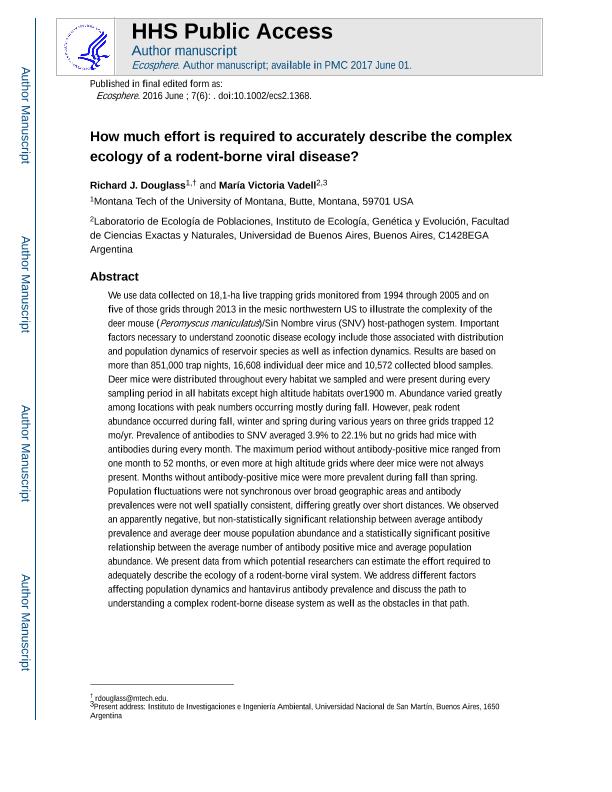Artículo
How much effort is required to accurately describe the complex ecology of a rodent‐borne viral disease?
Fecha de publicación:
06/2016
Editorial:
Wiley
Revista:
Ecosphere
ISSN:
2150-8925
Idioma:
Inglés
Tipo de recurso:
Artículo publicado
Clasificación temática:
Resumen
We use data collected on 18, 1-ha live trapping grids monitored from 1994 through 2005 and on five of those grids through 2013 in the mesic northwestern United States to illustrate the complexity of the deer mouse (Peromyscus maniculatus)/Sin Nombre virus (SNV) host-pathogen system. Important factors necessary to understand zoonotic disease ecology include those associated with distribution and population dynamics of reservoir species as well as infection dynamics. Results are based on more than 851,000 trap nights, 16,608 individual deer mice and 10,572 collected blood samples. Deer mice were distributed throughout every habitat we sampled and were present during every sampling period in all habitats except high altitude habitats over 1900 m. Abundance varied greatly among locations with peak numbers occurring mostly during fall. However, peak rodent abundance occurred during fall, winter and spring during various years on three grids trapped 12 months/yr. Prevalence of antibodies to SNV averaged 3.9% to 22.1% but no grids had mice with antibodies during every month. The maximum period without antibody-positive mice ranged from 1 to 52 months, or even more at high altitude grids where deer mice were not always present. Months without antibody-positive mice were more prevalent during fall than spring. Population fluctuations were not synchronous over broad geographic areas and antibody prevalences were not well spatially consistent, differing greatly over short distances. We observed an apparently negative, but nonstatistically significant relationship between average antibody prevalence and average deer mouse population abundance and a statistically significant positive relationship between the average number of antibody positive mice and average population abundance. We present data from which potential researchers can estimate the effort required to adequately describe the ecology of a rodentborne viral system. We address different factors affecting population dynamics and hantavirus antibody prevalence and discuss the path to understanding a complex rodent-borne disease system as well as the obstacles in that path.
Archivos asociados
Licencia
Identificadores
Colecciones
Articulos(SEDE CENTRAL)
Articulos de SEDE CENTRAL
Articulos de SEDE CENTRAL
Citación
Douglass, Richard J.; Vadell, María Victoria; How much effort is required to accurately describe the complex ecology of a rodent‐borne viral disease?; Wiley; Ecosphere; 7; 6; 6-2016; 1-13
Compartir
Altmétricas




